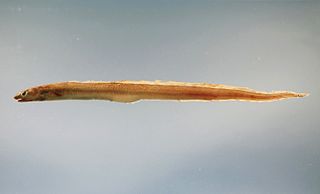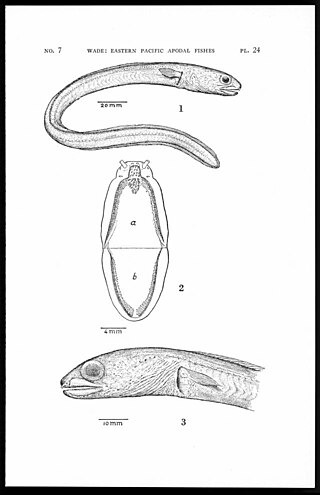
Conger is a genus of marine congrid eels. It includes some of the largest types of eels, ranging up to 2 m (6 ft) or more in length, in the case of the European conger. Large congers have often been observed by divers during the day in parts of the Mediterranean Sea, and both European and American congers are sometimes caught by fishermen along the European and North American Atlantic coasts.

The Congridae are the family of conger and garden eels. Congers are valuable and often large food fishes, while garden eels live in colonies, all protruding from the sea floor after the manner of plants in a garden. The family includes over 220 species in 32 genera.
Gnathophis is a genus of marine congrid eels.
Bathycongrus is a genus of eels in the family Congridae.
Bathymyrus is a genus of eels in the family Congridae. It currently contains the following species:
Chiloconger is a genus of eels in the family Congridae.

The garden eels are the subfamily Heterocongrinae in the conger eel family Congridae. The majority of the 36 known species of garden eels live in the Indo-Pacific, but can be found in warm ocean water worldwide. These small eels live in burrows on the sea floor and get their name from the behavior of poking their heads from their burrows while most of their bodies remain hidden. Since they tend to live in groups, the many eel heads "growing" from the sea floor resemble the plants in a garden. They vary in color and size depending on the species. The largest species reaches about 120 cm (47 in) in length, but most species do not surpass 60 cm (24 in). Garden eel colonies can grow as large as one acre in surface area and number up to several thousand individuals.
Parabathymyrus is a genus of eels in the family Congridae.

Rhynchoconger is a genus of eels in the family Congridae.

Xenomystax is a genus of eels in the family Congridae. It currently contains the following species:

The shorttail conger is an eel in the family Congridae. It was described by Charles Barkley Wade in 1946, originally under the genus Chiloconger. It is a subtropical, marine eel which is known from the eastern and southeastern Pacific Ocean, including Costa Rica, Ecuador, El Salvador, Guatemala, Honduras, Mexico, Nicaragua, the Galapagos Islands, Panama, and Revillagigedo. It dwells at a depth range of 108–150 metres. Males can reach a maximum total length of 30 centimetres.
Ariosoma coquettei is an eel in the family Congridae. It was described by David G. Smith and Robert H. Kanazawa in 1977. It is a tropical, marine eel which is known from the northern coast of South America, in the western central Atlantic Ocean. It is known to dwell at a maximum depth of 75 meters. It can reach a maximum total length of 28.1 centimeters.
The Californian conger, also known as the ringeye conger, is an eel in the family Congridae. It was described by Robert H. Kanazawa. It is a tropical, marine eel which is known from the eastern central and southeastern Pacific Ocean, including Colombia, Costa Rica, Ecuador, El Salvador, Guatemala, Honduras, Mexico, Nicaragua, Panama, and Peru. It is known to dwell at a depth of 50 metres. Males reach an average total length of 40 centimetres, but can reach a maximum TL of 60 cm.
The margintail conger is an eel in the family Congridae. It was described by Felipe Poey in 1867, originally under the genus Echelus. It is a subtropical, marine eel which is known from the western Atlantic Ocean, including the United States, Bahamas, the Gulf of Mexico, Cuba, Venezuela, and Colombia. It is known to dwell at a depth range of 35–75 meters, and leads a benthic lifestyle, inhabiting sand and mud in the neritic zone. Males reach an average total length of 35 centimeters, but can reach a maximum TL of 51 cm.
Paraconger guianensis is an eel in the family Congridae. It was described by Robert H. Kanazawa in 1961. It is a tropical, marine eel which is known from French Guiana and northern Brazil, in the western Atlantic Ocean. It is known to dwell at a depth of 73 metres.
The blackspot conger is an eel in the family Congridae. It was described by Albert Günther in 1870, originally under the genus Conger. It is a subtropical, marine eel which is known from the eastern Atlantic Ocean, including Madeira and Azores. It dwells at a depth range of 30–100 meters and burrows into sand. Males can reach a maximum total length of 50 centimetres.
The Guinean conger is an eel in the family Congridae. It was described by Robert H. Kanazawa in 1961. It is a tropical, marine eel which is known from Senegal to Angola, in the eastern Atlantic Ocean. It dwells at a depth range of 25–50 metres, and inhabits benthic sand, which it burrows into backwards. Males can reach a maximum total length of 62.7 centimetres.
Paraconger ophichthys is an eel in the family Congridae. It was described by Samuel Garman in 1899, originally under the genus Atopichthys. It is a tropical, marine eel which is known from Cocos Island, in the eastern central Pacific Ocean. It is known to dwell at a depth of 1953 metres.
The Bullish conger is an eel in the family Congridae. It was described by David G. Smith and Robert H. Kanazawa in 1977, originally under the genus Rhechias. It is a marine, deep water-dwelling eel which is known from the Gulf of Mexico to the Amazon, in the western Atlantic Ocean. It dwells at a depth range of 366–475 meters. Males can reach a maximum total length of 39.5 centimeters.

Bathymyrinae is a subfamily of marine ray-finned fishes belonging to the family Congridae, which includes the conger and garden eels. The eels of this subfamily are most diverse in the Indo-Pacific region but are also found in both the Eastern and Western Atlantic Oceans.







